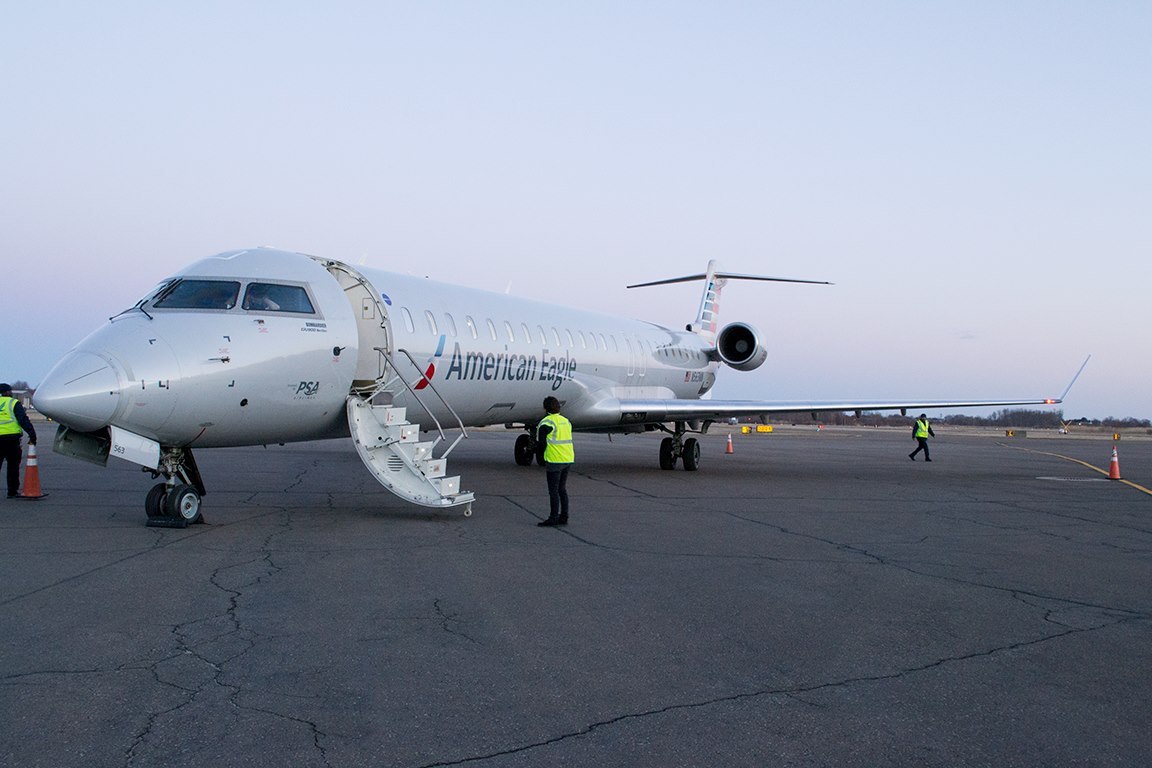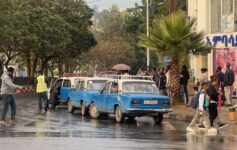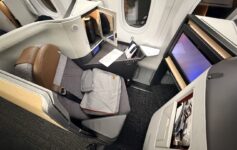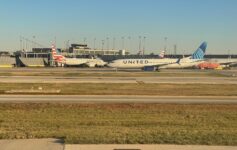
An aviation photographer was physically detained on a recent American Airlines trip by crew members after a flight attendant suspected he was taking pictures of the flight crew. American Airlines has now responded.
Man Is Physically Detained By Flight Crew On American Airlines – PSA Flight Over Photo Controversy
I’ve been sitting on this story for a few days waiting to see how American Airlines responded and now we have a response. Let’s first review what happened.
- The incident took place on PSA, a wholly-owned regional carrier of American Airlines (therefore, in my opinion, on American Airlines)
- Jeremey did take pictures onboard (one of which is included below), but did not happen to take any pictures of the crew
- A flight attendant saw him taking pictures and called out to the captain to physically block him from leaving the jetbridge upon arrival.
- Jeremy was brought back onboard, where the flight attendant demanded he prove to them that they were not in his recent photos
- After he opened up his photo library, the flight attendant grabbed the phone from his hands to inspect
- Jeremy wonders whether he was unlawfully detained
Honest question: can a crew member physically prevent me from getting off of the airplane until I showed them the contents of my phone (they wanted to see the last 3 photos) to verify that I did not take a photo that contained them in it. pic.twitter.com/d6m42a8ck4
— JDL (@photoJDL) October 28, 2022
Jeremy complained to American Airlines. In a follow-up tweet, he shared how AA responded:
- AA apologized profusely
- AA admitted the FA cannot touch my phone
- “The rest was squishy, and all I got on the functional detainment was to the effect of ‘it’s not how I would’ve done it”
- AA has opened an internal investigation on the incident and will speak with the FA
- AA will use the incident to review its photo/video policies
- No compensation was offered
AA’s photo policy (as conveyed to Zach Honig after a similar incident in 2015) allows for photography onboard and does not explicitly ban including employees in such photos or video:
“American allows photography and video recording for personal use. For many customers, taking photos and sharing them on social networks has become part of their travel experience. When photographs and video are used for professional purposes, we do our best to notify flight crews so they are aware and prepared to offer some additional latitude with journalists and bloggers.”
The line between personal and professional is deliberately vague – how does this blog, which I write not to earn a living but because I enjoy it, fit in? How about for Jeremey, who clearly was not on a photo assignment taking a cell phone picture of a regional jet?
This reminds me of my own photo incident on United Airlines, where a flight attendant falsely accused me of taking a picture of her. United has since greatly loosened its onboard photo policy.
Here’s how I approach pictures on airplanes:
- If I am reviewing an airline, I will focus my pictures on the product itself (seat, meals, amenities, etc), but may include crew members, especially if they are standing around as I board the flight and try to capture cabin photos before other passengers boarding
- Sometimes flight attendants will be in pictures during meal service, especially if using carts
- If I encounter particularly wonderful flight attendants, I will ask to take their pictures before doing so (especially if I am going to name them in a story)
- Isn’t it interesting that all the flight attendants who provide excellent service never have an objection to being photographed?
- If I am asked to stop taking pictures, I will stop
- If I am asked to delete pictures, I will run a cost/benefit analysis before complying (more on that below)
There’s a common retort to these sorts of situations that goes something like this:
“How would feel if someone came into your office and started taking pictures of you?”
I view that as a pretty weak analogy. For decades, flight attendants had to be beautiful young women precisely because that was viewed as such an integral part of the public-facing airline product. While I am glad we are past those days, there is a huge difference between a customer-facing flight attendant and walking into a law office or factory or even grocery store to snap photos of employees. Flight attendants and pilots, by their uniforms and grooming standards, maintain a visible public-facing link between the airline and passengers.
If this incident had happened to me, I would have evaluated whether it would have been worth being banned from American Airlines for non-compliance. The flight attendant and pilot had no legal right to detain Jeremy onboard or make him delete his pictures, even if they were photographed against their will. But American could decide it no longer wanted to do business with such a “troublemaker.”
So let me be very real. On United and Lufthansa, I would comply immediately. On other airlines, probably not. Now recall that just recently I had another photo incident with Air Algerie. There, a ticketing agent with a cigarette handing out his mouth demanded I delete a picture of the check-in desk. I did…because I was scared of being in a foreign nation in which I did not speak the language. Had this been the USA, I would have flatly refused his demand.
CONCLUSION
This is a fascinating topic, particularly in an age in which the use of mobile phone cameras has proliferated to such an extent that it is common for people to photograph just about anything. Jeremy should not have been detained and American Airlines owes him more than an apology. That said, when we run into issues like this we must be discerning…there may not be a legal issue with taking photos onboard, but there could well be a negative practical implication if banned from the carrier.
image: Tweed Mythbusters




“…becuase I was sacred being in a foreign nation…”
You’re not that sacred Matthew.
This wasn’t Denmark.
I was on Aer Lingus recently for the first time in a while and the announcements made pre-flight were clear that photography of the crew was not allowed but other photography is. I can’t imagine how they police it and it all seemed a be pointless.
In this account, we again see AA crew acting out of all proportion to the law or reality.
I concede that federal law (outside my speciality) may delegate the cabin crew certain powers in the air to detain unruly or otherwise combative passengers in the wake of 9/11. These detentions can include plastic handcuffs or other methods of restraint. However, the moment that plane lands, pulls up to the gate and opens the boarding door, the crew loses any special powers. If the captain or flight attendant wanted a passenger detained they should have had the gate agent call police. Period. What the crew allegedly did in this circumstance constitutes a crime; in fact, several crimes. Depending on the jurisdiction, we are likely talking felonies for impersonating a police officer, unlawful imprisonment, kidnapping, and battery. The crime at common law of disturbing the peace would certainly be a catch-all too.
So there are felony convictions for people who look at someone else’s phone for a few minutes, and then return it?
There aren’t a ton of details here, but there will be 2 sides to such a story. While Jeremey may view himself as “physically detained” the pilot and FA may view him as voluntarily having a conversation with them, their physical presence near or at the doorway may be viewed as coincidental rather than an attempt to impede Jeremey’s egress
Good luck with the jury conviction of the pilot standing next to a plane that he just flew wearing a pilot’s uniform with name badge being charged with impersonating a police officer. As part of his defense he can use Jeremey’s social media posts in which he is identified as being easily recognizable as someone who was not a police officer.
As for kidnapping… would that also apply when I got stuck behind the beverage cart once when trying to get back to my seat during the drinks service?
Flying with these particular crew members must have been a real pleasure during the 2020-2021 mask SS police era.
Decades ago I used to proofread as a part-time job. Reading this makes my teeth itch.
We’ll issue you a refund.
Wait til Sunday.
Matthew and creddit – responses from opposite ends of the issue, but both funny.
Well written. Thanks for doing so.
Because of social media, I prefer that anyone who takes a picture of me be someone I’ve said it’s ok to. In the old days, when the widespread publishing of photos wasn’t a concern, I didn’t even think about it. But photos can be used in all sorts of ways online and I prefer to limit that risk.
It’s just about being polite really, isn’t it?
The real way to set things off is to start taking pictures of my kids. My wife goes into a Mama Bear mode that would make this pilot/FA stuff look very tame.
And, no, I’m not talking about a general scene in which my children are unintentionally in the background.
We have a child with an eye problem that required glasses at around 18 months– for some people this was irresistibly cute requiring photographs, sometimes close up facial shots of a 2-3 year old child without parental consent.
It seems like every single inconvenience is “made right” by monetary or some other equal compensation.
I think if Jeremy wanted to pursue litigation, there’d be no way he wouldn’t prevail. He certainly didn’t violate any laws, and it sounds like he didn’t violate AA’s onboard photography policy either. The two employees almost certainly broke the law, and definitely broke AA service policy. All members of society would be wise to assume they’re always being recorded at all times. You may not like it, but it’s reality, and supported by the courts.
As for this blog constituting professional photography… c’mon dude, you most certainly do. You publish affiliate links to credit cards, you do make revenue from ads, and you specifically seek out (and photograph) aviation products around the world with a profit motive. Whether that motive is clicks or content to support your travel concierge business, doesn’t really matter, right? (And don’t worry, I’m not hating. Please keep up all the good work… you’re the only pro left!)
Really? So if you’re the pilot and the FA, and you say the following “We were concerned that he was taking photographs that violated our corporate policy, so we asked him to show us three pictures on his phone. He was initially reluctant, but we discussed it with him and explained our concerns and he agreed to show– even handed us his phone so we could look at it. We returned the phone to him after looking at it. We didn’t restrain or detain him. We simply asked him to join us in this conversation and he did. We didn’t refuse to let him leave. He was free to leave at any point. He never even asked to leave. He even had his cell phone in his hand for the majority of this interaction, he could even have called the police himself if he felt threatened, or wrongly detained, but clearly he didn’t. He left our presence with the cell phone and didn’t call the police then either. He didn’t even tweet about it for 2 hours after the event. The whole thing took place in just a few minutes.”
It doesn’t matter if this isn’t exactly what happened on the day– maybe they did block him in and bully him into giving up his phone, but you can bet that’s not their side of this. If you have a group of people giving a consistent story, and they seem credible and believable, and on the other hand one person claiming that he was wrongly detained for 15 minutes this becomes a “they said, he said” type of case there is no guarantee you prevail in such a situation. Beyond that, what are the damages here, the loss of his 15 minutes of time?
Did you know that he has admitted publicly to being aware that AA has a photography policy, but that he did not know what it said?
We haven’t even gotten to the nasty tactics here yet…
I’m not saying what those people did was right, or that I defend their actions, but if you have ever sued someone or been sued you know that unless this guy has some better documentation of this event than has been revealed thus far, that this is far from a slam dunk big dollar win.
My mistake, he said that he acknowledged that AA may have a policy, but that he has not read it.
If the way you recount the events is accurate, than I’d certainly agree with you. My understanding is that he was physically blocked, forced back on the aircraft, and had his phone snatched from him. I do not believe those actions to be legally permissible, nor in line with AA policy. I suppose it would be up to a jury to determine the value of a settlement, but it does seem to me that AA probably owes him something.
I agree with Jerry’s assessment. That’s how I interpret the events too.
I’m not recounting events or saying that I know what happened.
All we know is based on one guy’s twitter account.
There will be another side to this story, and I’ll bet it doesn’t involve a group of people admitting that they kidnapped a passenger and stole his phone.
911 was the reason that it is not allowed to photograph flight attendant procedures. The author should be aware of this.
Are you for real? That was over 20 years ago. It’s time to move on.
Are you for real? Sept 11th changed the airline industry in a few horrific hours. It does not matter if it was 20 years ago or 20 minutes. Inflight security became Item Number One for every crew member. I attended several memorial services for AA flight attendants and pilots that died that day and saw first hand the crushing agony of their families and colleagues. There is a real reason for our hyper vigilance—the bad guys continue to probe and look for weaknesses to this day. The next 9/11 will occur and if it seems like monitoring photography is excessive, rest assured it is not. Just ask permission and try to explain why you want to do it and respect their wishes. The FA and pilot you profiled were wrong to detain the person and take his phone and you can be assured that a very unpleasant meeting took place with those involved.
Sorry, we live in a new era in which everyone has a camera on their person. Taking pictures should not be viewed as suspicious except by those who choose to live in the fear of the past, not the present reality. Secure cockpit doors will prevent another 9/11 and could have prevented the acts on 9/11/2001. There is no need to be afraid of people taking pictures.
Flight attendants may simply be worried about harassment, bullying, extortion, intimidation from being photographed, thus affecting their ability to engage in work and consortium.
While I get the desire to generalize a specific incident, I find it misses the point. Nearly everyone has a bad day and reacts excessively to others. We’d all hope professionalism alone would triumph over personal lapses. It never has. So I agree with prior comments that simply being kind is the central issue. Part of being kind is forgiving and moving on. We’re never going scold humans into perfect behavior. The FA was wrong. Nobody is really disputing that. The captain backed up the FA, which in my view is the correct action. Glad this didn’t happen to me. The passenger seemed to respond well and didn’t escalate. By contemporary standards, this story has a relatively happy conclusion.
Doesn’t what the Captain did constitute “false imprisonment”? It would be interesting to see how a false imprisonment lawsuit would go.
Which do you think the captain is more likely to say, if asked “Yes, I imprisoned him.” or “No. Absolutely not. I asked him to walk over to where the flight attendant was standing so that we could all discuss this situation with the flight attendant who raised the concern, so that we could address the concern, and he voluntarily did just that.”
I took photos of the bar on Emirates once, and the flight attendant asked me to delete any photos she was in. I happily complied, showed her my phone, and we had a pleasant chat about other stuff. Sounds like the AA FA really went off the handle.
I’d check with an experienced, like Kevin Hogg, former Navy Pilot and one that spent his whole career at LAX, just one of two full time, FBI agents; because, there are different levels of enforcement and law onboard an aircraft. For instance, is the door closed, is it in the air or on the ground, technical crew versus flight attendants, policy, training, code of federal regulations, administrative law, criminal law, directives, orders, and so forth. You are protected constitutionally against unlawful searches and seizures, retiring from LAX as a Homeland Security Special Agent I would not ever grab someone’s communication device as done in this circumstance. I can detain you, arrest you, ir just use my good looks to reason with you, but not without chapter and verse of the authority and law behind me memorized, just sets bad case law and precedent for a situation where it just wasn’t necessary. Instead of just wandering through an airport take a few minutes to learn what everyone’s job responsibilities are: TSA, Airport Police, LAPD, Postal Inspectors, FAA, baggage, ticketing, traffic, the list goes on indefinitely. And do this before something goes wrong. The bad guys and good guys can sense who knows what they’re talking about!
I had an incident on Nov 4th where another passenger ahead of me sitting in an aisle (she sat in C aisle and I sat in D aisle) took my photo and texted it to someone. I could see her phone from my vantage point and that she was texting back and forth with someone. I have never met this or spoken to this woman in my life. It’s also important to note she was White and I am not. One month later and I still feel incredibly violated and American Airlines said they can’t do anything about it.
This happened to me recently. By another guy. I have to wonder what the point of that was.